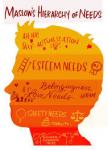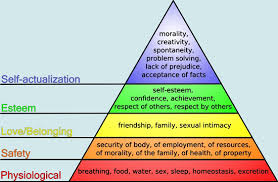
American psychologist Abraham Maslow was famous for his hierarchy of needs. His paper "A Theory of Human Motivation," written in 1943, laid the framework for the hierarchy of needs, and his book, "Motivation and Personality," written in 1954, went into the hierarchy in more detail. Both are still widely referenced in modern day developmental psychological theory. Maslow's Hierarchy of Needs is used in psychological instruction at both the undergraduate and graduate level, training for management, and sociological research.
Maslow had a deep desire to understand personal motivation and the driving force behind individuals. During his research, he created a pyramid outlining the needs of healthy people and proposed that people meet these needs in a hierarchy format; some needs are more important than others and are even basic and premortal. Others are less basic and of lesser importance to the person's overall well-being, but not progressing through the pyramid to the top prevents the person from realizing his full potential.

At the bottom of the pyramid are what Maslow deemed deficiency needs. These needs only cause a person to feel anxious when they are not being met; when they are being met, the person doesn't even realize that the needs are important.
At the very bottom of the deficiency needs is physiological needs. All people need to eat, breathe, drink water, sleep, use the bathroom, and be intimate. Slightly less base than those needs are the safety needs, including feeling secure in one's body, employment, family, health, property, and morality. Love and belonging are on the third rung from the bottom; people have a need to feel loved by family, friends, and intimate partners. The fourth rung is esteem; the need for achievement, respect, confidence, and self-esteem are found in this level of the hierarchy.
Maslow theorized that the bottom four levels of the pyramid had to be met before the person could reach the self-actualization level of the pyramid and realize his full personal potential, experience personal growth, and become self-fulfilled. He also theorized that very few people have the ability to self-actualize, since it requires independence, creativity, objectivity, awareness, and honesty.
When deficiency needs go unmet, then people become motivated to have them met. For example, it is a basic instinct to breathe. If you hold your breath under water, you can only do so for so long before you are motivated to come to the surface to get the oxygen your body needs to survive. Similarly, if you are hungry, you are motivated to eat. If you are lonely, you are motivated to find a friend.
Progress through the deficiency needs of the hierarchy is many times derailed, preventing most people from ever achieving self-actualization. Job loss, divorce, and other events can cause a person to hover between hierarchy levels, unable to reach the top. Maslow estimated that only one percent of people reach full self-actualization because, he theorized, that society offers motivational rewards largely based on social needs such as love or self-esteem.